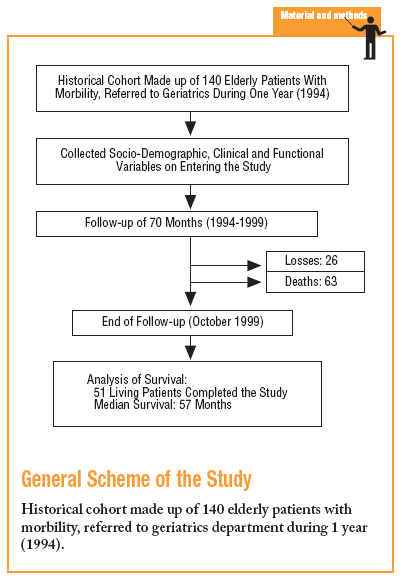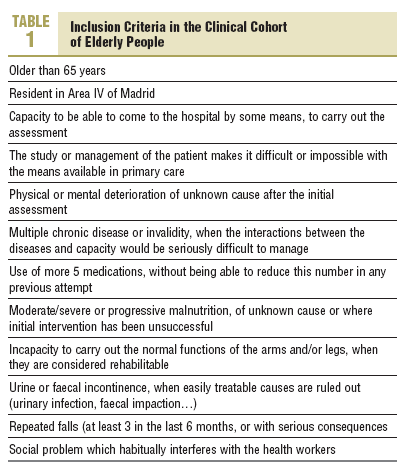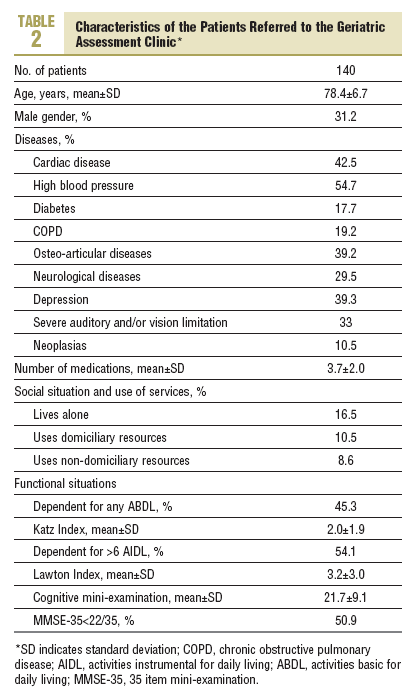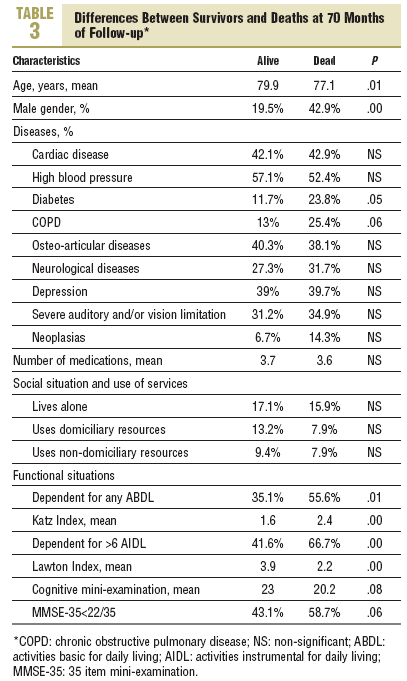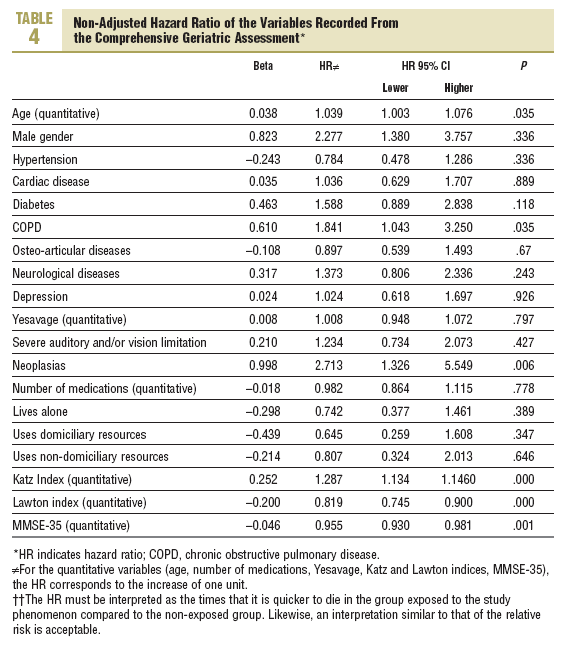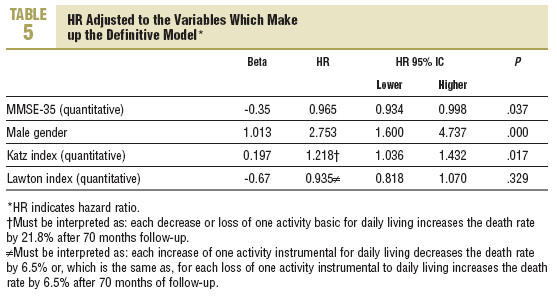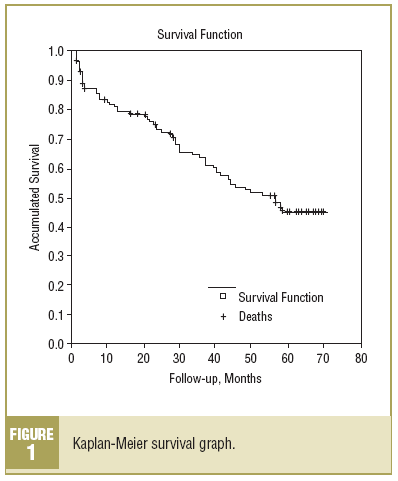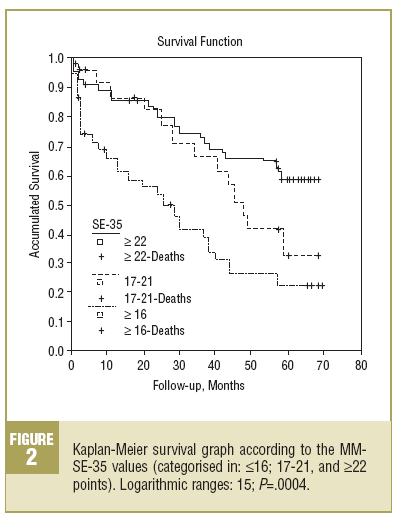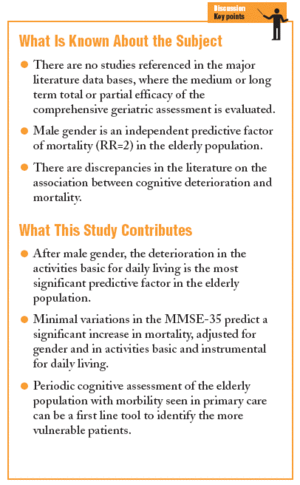Introduction
The progressive increase in the population >65 years old1 in our country is, from a public health perspective, a problem of great concern which requires social and health measures to be adopted. These measures must include screening for incapacities and medical, functional, psychiatric and social problems, with the objective of designing a therapeutic and care plan, as well as long term follow-up. This clinical-preventive approach was the idea of the first British geriatricians2 and has been given many names: multidisciplinary geriatric assessment, integral or exhaustive geriatric assessment and comprehensive geriatric assessment (CGA), this latter one being the most prestigious. Five parameters are studied3: organic health or disease, mental function, functional situation, social support, and economic situation.
In short and medium term studies carried out on non-institutionalised elderly people in our country, the relationships between some of the assessments included in the CGA (Katz index and cognitive deterioration) and mortality have been highlighted.4,5 However, we have not found any studies where the relationship between these assessments, and others contained in the CGA, and the reduction in survival have been evaluated for more then 5 years. This deficiency should be rectified, since elderly patients take up 50% of the professional time of the primary care doctor,6 and it is the most suitable field for prevention and early diagnosis.
The objective of this study is to identify and prioritise the aspects of CGA, carried out in a hospital geriatric assessment unit, which may better predict the mortality of our elderly at 70 months, with the purpose of incorporating those aspects, which should enable the most vulnerable patients and those who might benefit more from health interventions to be detected, into the routine work of family doctors.
Patients and Method
A retrospective observational study of cohorts (historical cohort) has been carried out, which included all the elderly patients who were sent to the Geriatric Assessment Unit of the Ramon and Cajal Hospital during the year 1994, if they complied with the following established criteria: the first 3 and any of the other 9 of the points in Table 1.
The progress of all the patients was observed from 1994 to October 1999 (cut-off point for convenience), by using the hospital clinical records. Besides the time of survival in months, at the beginning of follow-up the following qualitative variables were collected using the CGA: gender, cardiac disease, blood pressure, diabetes mellitus, chronic obstructive pulmonary disease (COPD), diseases of the locomotor system which might involve a limitation for the patient, neurological diseases, auditory and ophthalmic diseases which might involve a limitation, neoplasias, number of medications consumed at the time of being given the geriatric assessment, depression (diagnosed according to DSM IV criteria), living alone, and use of social resources. Likewise, the quantitative variables collected at the beginning of the study were: age, Yesavage scale (this has the detection of depression as its aim and is specifically designed for the elderly patient: in our study we have used his short version of 15 questions) and the Mini Mental State Examination with 35 items (MMSE-35). The Katz and Lawton index variables, which are qualitative ordinals, were categorised as quantitative (for the Katz index: A=1, B=2, C=3, D=4, E=5, F=6, G=7, and for the Lawton: total independence, 8 points, decreasing to 0 points depending on the number of functional limitations), although, for the comparison of the mean results between deaths and survivors non-parametric tests were used (Mann-Whitney U test).
At the end of the follow-up period the data from the final outcome (morbility and mortality) of these patients were collected by reviewing the primary care clinical histories, computerised records of the hospital and, lastly, by telephone calls to the patients or their families. This data was entered into a database where the variables which could identify the patient were separated, complying with the data protection guidelines.
Statistical Methods
A descriptive analysis of each of the study variables was carried out, summarising the qualitative nature using absolute and relative frequency tables, and the quantitative nature using the mean ± standard deviation.
For the comparisons, the *2 test was used for the qualitative variables and the Student t test for the quantitative ones.
With the aim of finding out the independent predictive variables of mortality after 70 months of follow-up, a Cox regression model was constructed, for which the hazard ratio assumption is previously verified using the visual observation of the Kaplan-Meier survival curves and log minus log graphs in the stratified models for each covariable. To select the variables included in the model, a bivariate analysis with all the variables collected in the CGA was performed, making time of survival the dependent variable and the rest covariables. The variables with a level of significance ¾20% (male, diabetes mellitus, COPD, neoplasias, Katz, and Lawton indices) are included in the Cox maximum hazard ratio model, where we take the MMSE-35 as the main variable and the rest as control variables. The absence of collinearity of the variables which make up the maximum model is checked by applying a macro designed for this effect in those variables which may have correlation coefficients between them of <0.60.
Using the backward inference method (maximum verisimilitude), controlled manually, the variables with a worse statistical significance are suppressed, provided that, owing to the beta coefficient of the main predictive variable not varying by more than 10%, they may not be considered as confounding. The best possible definitive model is finally obtained. All the data was analysed with the Windows SPSS 10.0 statistics package.
Results
In the almost 6 years of follow-up 63 patients died, 51 continued living, and 26 were lost at some time in the study (not able to contact them or their families and/or new records of their outcome were not noted in hospital or in their health centre). The median survival was 57 months and in month 70 the accumulated survival was 45.4%.
From the basal data of the population studied (Table 2) a high frequency of illness emerges, particularly in processes such as depression, cardiac disease, diabetes, and neurological disturbances. At the end of the follow-up period (Table 3) there were significant differences in mortality in male patients, diabetics, those with a Katz index of > A (at least 1 limitation for activities basic for normal daily living [ABDLI]) and Lawton ¾2 (dependency in at least 6 activities instrumental for daily living [AIDLI]). On the other hand, the proportion of patients with an age greater than the mean (78 years) as well as those with a MMSE-35 score <22 had a higher tendency to die, but did not reach statistical significance (P=.07 and P=.08, respectively). The rest of the basic characteristics and outcomes of the 140 patients are described in Tables 3 and 4, respectively. It should be pointed out that patients who died had a significantly higher mean age value and Katz index, and a significantly lower Lawton index than those who lived.
The non adjusted hazard ratio (HR) and the significance of the variables considered in the study are set out in Table 5. The neoplasias (HR=2.7), gender (HR=2.2), and COPD (HR=1.8) are highlighted as the variables with a stronger association with mortality. In the multivariate analysis (adjusted HR), the neoplasia and COPD variables lost their statistical significance and left the definitive model, which remained composed of the MMSE-35 variables, gender and the Katz index as significant variables, and the Lawton index as a confounding factor (as can be seen in Table 5). From looking at this table it is seen that, as regards the Katz index, for each decrease or loss of one activity basic for daily living, the death rate after 70 months of follow-up increases by 21.8%. Likewise, with the Lawton index, for each increase of one activity instrumental for daily living, the death rate decreases by 6.5%, which is the same as, for each loss of one activity instrumental for daily living, the death rate increases by 6.5% after 70 months of follow-up. Finally, the effect of an increase of one unit of the MMSE-35 decreases mortality by 3.5%, that is to say, a reduction of one unit of the MMSE-35 (a situation more common than an increase) implies an increase of 3.5% (1-0.965) in the mortality at 70 months, adjusted for gender and activities basic and instrumental for daily living.
We have noted a good correlation (r=-0.625; P=.001) between the scores obtained in the Katz and Lawton indices (the negative correlation coefficient is due to both ordinal scales being categorised in reverse order). Given that the correlation is not perfect, we preferred to include the assessment of dependence for the AIDL (Lawton) although there should already be dependence for the ABDL (Katz), with the aim of measuring complementary dimensions of a same problem. In fact, of the 22 patients who had total independence for AIDL, 9 had one limitation less for the ABVD, such as mild degrees of urinary incontinence or difficulty in getting in or out of the bath without help. On the other hand, both indices did not behave as collinear in the multivariate analysis and, besides, the Lawton behaves as a confounding variable, therefore it is obliged to remain in the final Cox regression model.
As a verification of our findings, Figure 1 shows the probability of survival of the patients during the 70 months of the study, and Figure 2 the survival stratified according to the MMSE-35 score (according to the following categories: score ¾16, between 17 and 21, and >=22), with a level of significance associated to the logarithmic ranges test of .0004.
Discussion
The high prevalence of illnesses such as cardiac disease, diabetes, depression, or neurological complaints can be explained by this being a very select population. On the
other hand, the low proportion of elderly with oncology problems, which made up part of the cohort, may be due to the elderly who had cancer mainly being sent to palliative care units or were followed-up by the hospital oncology department. By this same reasoning, it has to be thought that the elderly with cancer in our cohort are those with a better short term prognosis, and this could explain its lack of association in the adjusted model.
There are discrepancies in the literature for7-17 and against18,19 the association between the severity of cognitive deterioration and survival. With this study we support the presence of this relationship in our area. As regards the tools for cognitive assessment, Abizanda4 used cut off points in the MMSE, Baldereschi et al12 the diagnostic criteria of dementia from the DSM-IIIR and other authors, such as Freid et al,20 evaluation scales different from MMSE. We have preferred to take MMSE-35, given its high sensitivity and specifity and for being valid for the geriatric population in our environment.21 Likewise, we have categorised the MMSE-35 as a discrete quantitative variable with the objective of not losing information and quantifying the effect the small variations in scores on the scales had on mortality.
As regards the marked significance of physical dependence on the mortality, our results agree with those obtained by Gambassi et al,18 Narain et al,22 and other authors.4,20,23
To be male has been shown to be an independent predictive factor, with a mortality risk of approximately
twice that of women, in different studies,13,20,22,24 and as was obtained in ours (HR=2.75).
Although age may appear as a potential confounding variable on being associated with the risk of death and with the worsening of the MMSE-35 score,7,12,18,24 it has not behaved as such, as has also happened in other studies.22,25,26 However, other authors found it necessary to adjust for age.27 Despite our sample having been consecutive patients attending the Geriatric Assessment Unit, we believe that it can be considered as a non-biased clinical cohort since, on the one hand, it has been made up of the whole population of patients sent to this unit and, on the other hand, the period of inclusion in the study had been 1 year, therefore it has avoided the seasonal nature of certain diseases. For this reason, it should be treated as a non-representative sample of the group of elderly people who live in the area, even though those who present with morbility and morbidity have to be sent to the Geriatric Assessment Unit according to the criteria in Table 1.
In conclusion, it is observed that, after adjusting for gender, the ABDL (Katz index) and the AIDL (Lawton index), for each one point increase
in the MMSE-35 it will decrease the probability of dying by 3.5% (HR=0.965) or, said another way, given that it is going to be difficult for an elderly person to improve his/her MMSE-35 score with time, each point decrease in the MMSE-35, will increase the risk of mortality at 70 months by 3.5%.
To avoid inaccuracies in the determination of the MMSE-35 it is recommended, as was done in our study, that the assessor who carries out the MMSE-35 receives previous training and the person is not changed at any time. However, we are conscious of the possibility that in normal clinical practice a decrease of one point of the MMSE-35 may be due test-retest variability or to variations occurred due to a change of the assessor, more than true changes in cognitive function. Therefore, it would be more interesting to find out the effect on the mortality of changes of 3, 4, or 5 points in the MMSE-35. To calculate it only requires multiplying the MMSE-35 beta coefficient by the appropriate number (3, 4, or 5) and exponentiate it. The result of this simple operation would tell us that a decrease of 3 points increases the risk of mortality by 10% (HR=0.90), of 4 points by 13% (HR=0.87), and 5 points up to 16% (HR=0.84).
Therefore, small or medium variations in the MMSE-5 predict a significant increase in mortality. For this reason we believe that the cognitive assessment of elderly patients with morbility seen in primary care can constitute a tool of the first order to identify the most vulnerable elderly people and can at the same time help us to plan our clinics, the needs of referral and resources and, in short, to improve the quality of care for our patients.
However, other studies with similar characteristics are necessary in the field of primary care which would give external validity to our findings and to determine what would be the most appropriate intervals to carry out the cognitive assessment of our elderly.







